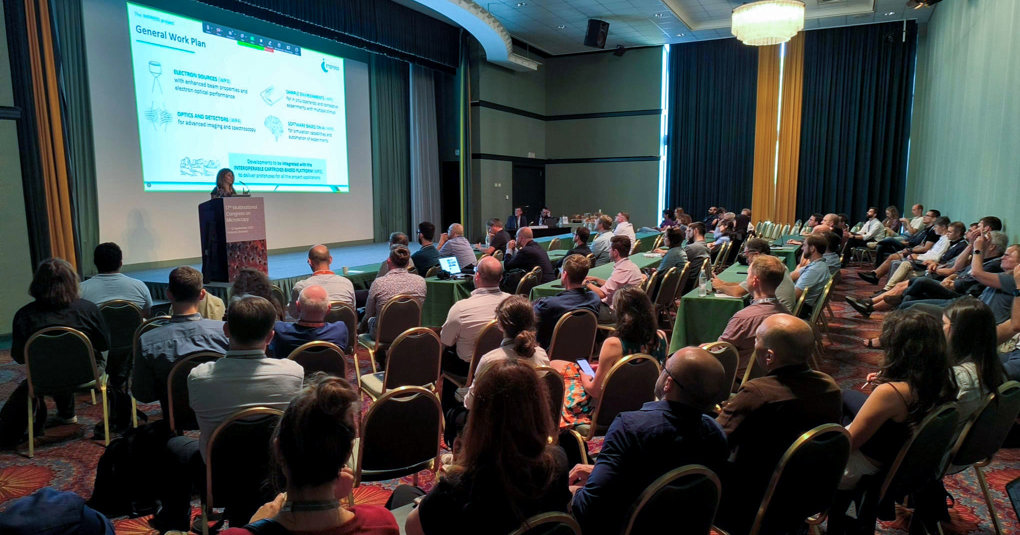
IMPRESS at 17MCM: Shaping Tomorrow’s Transmission Electron Microscopy

At the 17th Multinational Congress on Microscopy in Portorož, Slovenia, the IMPRESS special session “Shaping the Future of Interoperable TEM” drew scientists into a vivid dialogue on standardization, modularity, and co-creation in transmission electron microscopy.
From 7 to 12 September 2025, Portorož became the meeting ground for scientists and industry experts gathering at the 17th Multinational Congress on Microscopy (17MCM). Held every two years, the congress serves as a showcase for recent scientific results obtained through advanced microscopy methods, while also spotlighting the latest theoretical and instrumental breakthroughs. Beyond the science, it fosters collaboration across disciplines, provides a platform for microscopy-related companies to present their newest technologies, and - crucially - creates the connections that underpin future progress.
Within this vibrant setting, IMPRESS hosted its special session “Shaping the Future of Interoperable TEM” on 11 September. For two hours, around 80 participants followed a carefully crafted program that brought together leading voices in electron microscopy. Regina Ciancio, IMPRESS Project Coordinator from AREA Science Park opened with a clear vision of how the project aims to develop a standardized, cartridge-based interoperable platform for transmission electron microscopy. Her introduction set the tone for a session that would not only present state-of-the-art advances but also invite the community to reflect on future directions for TEM.
Amir Hossein Tavabi from Forschungszentrum Jülich took the audience on a journey into a bold vision for co-developing the future of TEM with researchers and SMEs. Axel Lubk from IFW Dresden advanced the discussion by exploring next-generation electron source optics, while Luiz Galvão Tizei from CNRS-LPS Orsay explained how adaptive optics and novel detectors could open new experimental avenues. Vittorio Morandi from CNR-ISMN Bologna then introduced fresh directions in operando and correlative TEM, before Enzo Rotunno from CNR-Nano Modena showcased how AI-driven, data-centric workflows are reshaping automation in microscopy.
The roundtable that followed brought the discussion into focus. Rather than redesigning microscope columns, IMPRESS is working toward standardized open interfaces and modular components as a promising way forward. These must be co-developed with SMEs and the scientific community to ensure adaptability across instruments and responsiveness to evolving experimental needs. As Regina Ciancio emphasized during the discussion: “In this way we can make TEM really interoperable and bridge it with other communities. Everything we develop is carefully designed, taking into account the inputs we received from user communities.” The conversation underscored both the ambition and the complexity of this undertaking. Participants also addressed timelines - prototypes are expected within a year - and stressed the importance of an iterative, co-development process with companies.
Questions from the audience sharpened the debate. Would unified designs risk slowing down innovation cycles? Could such an initiative remain sustainable beyond the Impress project period? And how can interoperability succeed in a worldwide context? The panel’s responses pointed in clear directions: sustainability is being pursued through stronger European networks and long-term initiatives; innovation can be supported, not slowed, by keeping interfaces open and flexible; and partnerships with companies and international communities are already taking shape.
As the discussion closed, one principle stood out: electron microscopy must connect more strongly with the wider scientific ecosystem. By creating shared standards, fostering open knowledge, and engaging SMEs and users alike, projects such as IMPRESS can change not only how instruments are built but also how communities collaborate.
The Portorož session left its audience energized for the work to come. Standardized interfaces may seem a technical matter, but in fact they point to a cultural shift towards openness, co-creation, and shared responsibility for shaping the tools of tomorrow’s science. The 17MCM provided the stage, but the ideas set in motion at IMPRESS’s special session will carry forward, evolving through prototypes, partnerships, and the persistent efforts of a community determined to reimagine transmission electron microscopy together.